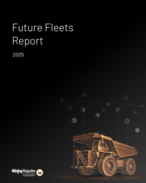Hydraulic lines in underground machines – particularly on boom-mounted drills – come in for particular scrutiny because of the harsh underground environments, the extra hazards and the fact that accidents are usually much worse when they are beneath the surface.
In underground coal mines, the safety requirements are even higher, with intrinsically safe fittings such as hose fittings which have no aluminium in them to avoid generating a spark if the fitting is struck with other metal objects such as tools.
Neil Marchant, business development manager with the Newcastle branch of machine hydraulics specialist Custom Fluidpower, told MiningNewsPremium.net that under the correct conditions, aluminium can be a fire hazard.
“When it’s struck by a shifter or something, it can cause a spark and the type of spark that it can cause can ignite [methane] gas,” he said. “It’s an old legislation and in Queensland they’re now allowing aluminium in some cases.
“Depending on the location of the hose and the possibility of someone being struck if the hose ruptured, quite often the hoses over here are under [mine design guideline] MDG41, which is a [requirement for a] pressure dissipation sleeve,” Marchant said.
“If the hoses are in a position where there are no guards on, there is potential that someone could be injured if the hose ruptured and if they hadn’t put on the pressure dissipation sleeve.
“With the sleeve on, if the hose ruptures the oil hits the sleeve and runs down, rather than coming out under pressure,” he said. “Hose management is the biggest issue on a lot of underground machines, like roof bolters and so on.”
Marchant said advances in hydraulic pump technology in recent years had improved safety and reliability.
“Where in the past many of them used to gear pump systems, now a lot of manufacturers are going to variable displacement pumps. The old gear pump circuits are very much like the old agricultural-style systems, whereas the new ones are much more high-tech,” he said.























